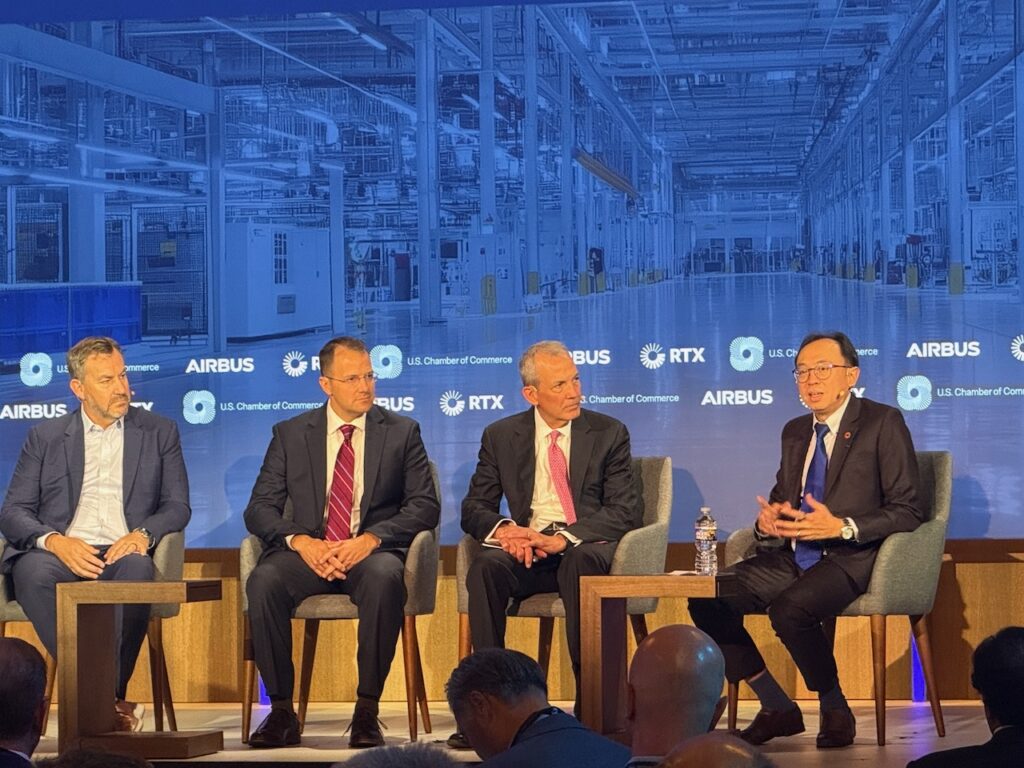Subscription Required
By Chris Sloan
Sept. 29, 2025, © Leeham News: At the U.S. Chamber of Commerce Global Aerospace Summit in Washington, D.C., on September 9, Airbus CEO Guillaume Faury reminded attendees that propulsion alone cannot deliver the performance leap expected from future aircraft. He said Airbus is targeting a 20–25% overall fuel efficiency improvement and noted that “half of it will come with the propulsion. When we integrate the bigger engine to be more efficient at the engine level, there are some losses. So the other half will come from the wing, aerodynamic efficiency, weight, and those kinds of things.”
This “other half” is why advanced materials and manufacturing are stepping into the spotlight. The conversation, moderated by Kevin Chow, EVP and Head of Aerostructures and Systems, Commercial Aerospace, ST Engineering, centered on next-generation programs, which are no longer just about engines or even airframe design. It is about how to build aircraft faster, lighter, and with greater precision to meet historically high production rates.

(Left to Right): Daryl Taylor, Senior Vice President, U.S. Commercial Operations, Airbus; Eric Hein, Director, Strategy and Product Development, National Institute for Aviation Research, Wichita State University; Tom Gentile, Chairman, CEO, and President, Hexcel Corporation; and panel moderator Kevin Chow, EVP and Head of Aerostructures and Systems, Commercial Aerospace, ST Engineering.
Slowing History, Faster Targets
Airbus aims to produce 14 A220s per month in 2026 and 75 A320 family aircraft per month in 2027 — a dramatic increase from current output. Daryl Taylor, Senior Vice President of US Commercial Operations, said that “historically production rates in this industry take a long time to get up to speed.” He said Airbus is acting now to be ready when the following clean-sheet aircraft is launched: “We know that with that type of backlog we expect in the future, we’re gonna have a fully proven automated set of solutions to deploy.”
In Mobile (AL), Airbus operates two final assembly lines for the A220 and A320 families and is building a third that will open soon. Taylor said that “just throwing more people at the problem is not the answer. At Airbus, we think [automation] is critical to the core of our execution and ramp-up, so we are investing heavily in our own capabilities and making acquisitions. We’re not relying on others to do that.”
Robotics, Automation, and RPA in Practice
Taylor said Airbus is “deploying different solutions into our existing factories, our assembly environment, to get those technologies mature for better efficiency, better quality, and better safety for our employees.” The approach combines Robotic Process Automation (RPA) — software bots that automate repetitive digital tasks — with physical robotics for drilling, trimming, and canvasing tasks.
He said Airbus is focusing on five key areas: “flexible, modular assembly solutions,” “paint automation and digital printing,” “lights-out logistics,” “AI-driven quality control,” and improved safety and ergonomics. “Ultimately, we’re doing that to be ready to deploy the automated factory of the future,” Taylor said. “We expect to have a fully proven automated set of solutions to deploy as we launch the next generation aircraft because we need to ramp that aircraft very, very quickly.”
CFRP and the Materials Revolution
Tom Gentile, Chairman, CEO, and President of Hexcel, said that “the unique properties of carbon fiber composites are that it is five times stronger than aluminum and 30% lighter.” He said, “If you look at an older aircraft like the 737 or even the A320, they’re 15% carbon fiber by weight. The newer aircraft, like the A350 or the 787, are 50% carbon fiber by weight. And military aircraft like the F-35 or the new B-21 are essentially all carbon fiber.”
Gentile said, “The thing about carbon fiber production is it’s still, I would call it the teenage years in terms of the production processes.” He said, “The next generation carbon fibers will increase the textile strength, the stiffness, and also increase the compression. All of these properties will enable even better architectures for the future aircraft.”
He also said, “We’re doing a lot with infusion-at-the-point-of-manufacturing techniques using heated tools. That would significantly reduce the amount of capital investment.” Gentile added that higher-temperature materials like “carbon-carbon materials… can survive up to 4,500 degrees Fahrenheit” and are finding applications in space and hypersonic vehicles.
AFP, Additive, and FSDA: Scaling Precision
Eric Hein, Director of Strategy and Product Development at Wichita State University’s National Institute for Aviation Research, said, “We’re seeing a lot of advancements in things like automated fiber placement (AFP) in the way and the speed in which we’re doing that.” He said, “Those are things that are all going to enable all the same advancements in properties, advancements in cost and quality overall.”
Hein said, “We see people using additive to just enable the production system. Having a tool or shop aid or drill plate ready to go, the right thing needed, is something that has just found natural utility.” He said for certain hard-to-make parts, “you’ll see additive really be the process of choice there.”
Gentile called Full Size Determinant Assembly (FSDA) “truly one of these remarkable revolutionary concepts of manufacturing.” He said FSDA “not only saves time at the point of manufacturing, but also reduces the amount of scaffolding. You can literally use carts and just bring the structures together to join.” Gentile added that “having an engineered hole pattern where you can take one part out of an aircraft and theoretically replace it without having to go through the process of drilling out a different element” is an advantage for sustainment.
Related


